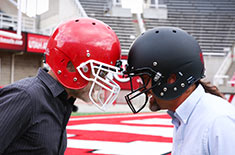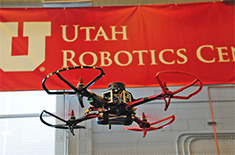Project title: Reducing Traumatic Brain Injury Risk with Smart Collision Detection and Mitigation The goal of the project is to reduce the risk of Traumatic Brain Injury (TBI) through smart technology that collects sensory data to predict and characterize impacts in real-time, optimizes protective mechanisms based on impact characteristics (e.g., direction, velocity), and transmits final impact attributes to a database for further analysis and injury risk prediction. This technology will substantially improve TBI prevention and diagnosis in motor vehicle crashes, sports, and industrial accidents. The unique technology will leverage musculoskeletal and biomechanical computational models linking head linear and angular...
Read MoreLeang, Pardyjak, & Nevada NanoTech Receive US Army DOD Grant to Develop Chemical Sensing Aerial Robot
Kam Leang and Eric Pardyjak partnering with company Nevada NanoTech Systems, Inc., receive US Army DOD grant to develop a chemical sensing aerial robot. The two-year $1,000,000 (Utah’s share of $330,000) project, entitled, “STTR Phase II: Autonomous Broad Spectrum Environmental Sentinels“, will focus on developing an autonomous, hover-capable, flying robot with integrated real-time chemical sensing, inter-unit communication and basics swarming capabilities, and the potential for self-powering. The final platform will detect and identify airborne chemicals using an onboard Molecular Property Spectrometer (MPS)—a low-cost, MEMS-based, lab-on-a-chip platform developed with support from DARPA and the DOD. This chip provides multi-mode chemical analysis with...
Read MoreProf. Jake Abbott receives funding for two-handed large-workspace haptic interface
The Utah Robotics Center recently added two 7-degree-of-freedom Quanser HD^2 haptic interfaces to the shared Large Robotics Lab (valued at $191,800). This equipment purchase was made possible with an award from the University of Utah Research Instrumentation Fund, lead by Prof. Jake Abbott, combined with generous academic discounts from Quanser. A haptic interface is a robotic force-feedback human-input device used to interact with virtual environments and teleoperate remote robotic systems. The haptic interface system will support research from robot-assisted retinal microsurgery to robotics for nuclear applications and nuclear facilities. The new equipment will be shared by the Robotics faculty in the Department...
Read MoreProf. Leang and collaborators receive new $3.8M NSF funding to work on electroactive polymer materials for soft robotics
Kam Leang in collaboration with UNLV-led team (Kwang J. Kim and Paul Oh) and other researchers receive new $3.8M NSF funding to work on electroactive polymer materials for soft robotics. Goal and Objectives: This international project addresses a technologically important issues in soft robotics. Soft robotics is an important emerging field in robotics, mechatronics, and automation. Soft robotic components and systems offer new features and advances over conventional robotic devices. This project focuses on the creation of advanced multifunctional artificial muscles (AM) based on new polymer-metal composites which can be used in soft robotic applications. Artificial muscles can be transformative for...
Read MoreProf. Meek receives new NIH grant to work on Quadrupedal Human-Assistive Robotic Platform (Q-HARP)
NRI: Collaborative Research: Quadrupedal Human-Assistive Robotic Platform (Q-HARP) Prof. Meek receives new 3-year $119,523 NIH grant to work on Quadrupedal Human-Assistive Robotic Platform (Q-HARP). Aging of the population has become a long-term trend in the United States. According to The State of Aging and Health in America, the U.S. population aged 65 and older is expected to double during the 25 years following 2007, and there will be 71 million American older adults, accounting for approximately 20% of the U.S. population by 2030. For the health and wellbeing of older adults, a key factor is being physically active. However,...
Read MoreProf. Leang receives NSF grant to work on temporal-spatial control of dual-stage nanopositioning systems
Prof. Leang and collaborators from industry (Molecular Vista, Inc. (MVI)) and Villanova University (Prof. Garrett Clayton) received a new NSF grant ($305,912) from Sensors, Dynamics, & Control program to study new design and control system approaches for the development of advanced nanopositioning systems for nanoscale science and engineering applications. More specifically, the new 3-year NSF collaborative Grant Opportunities for Academic Liaison with Industry (GOALI) research project focuses on new design and control paradigms for dual-stage nanopositioners that consider both spatial and temporal constraints. Emerging dual-stage nanopositioners have the unique ability to achieve both long-range and high-speed operation. However, typical control strategies rely on frequency-based...
Read MoreProf. Abbott receives NSF Collaborative Research: Shepherding Biomedical Microswimmers Using Magnetic Fields
Jake Abbott (PI) receives NSF grant entitled, “Collaborative Research: Shepherding Biomedical Microswimmers Using Magnetic Fields”. Total budget: $230,427, duration: 8/15/2014-8/14/2017. This project is in collaboration with Henry Fu at the University of Nevada, Reno....
Read MoreProf. Leang receives DOE STTR Phase I grant for high-speed AFM
Prof. Leang and industry partner Molecular Vista, Inc., San Jose, CA, recently received Dept. of Energy STTR Phase 1 grant, “Video-rate atomic force microscope for functional gas and liquid environments”. In this 9-month project, the team plans to develop a prototype video-rate AFM system for investigating materials in gas and liquid environments. The $150,000 project will allow the team to show proof of concept with the hope of pursuing a Phase II grant to continue the work....
Read MoreProf. Meek receives NSF NRI grant: Biologically-inspired, hybrid quadruped robot control
This research project is about designing better legs for legged robots. When a robot needs to move across rough terrain, as would be the case when searching for victims in a disaster area, legged robots have advantages over wheeled or tracked robots. They can traverse such terrain more easily, for example, stepping over fallen beams and bricks. However, legged robots are inherently more complex. They have many more joints and are more difficult to control. The goal of the project is to use ideas from nature to overcome some of these difficulties. The shape and compliance of four-legged animals...
Read MoreProf. Abbott receives NIH grant entitled, “Magnetic Guidance for Improved Cochlear-Implant Insertion”
Jake Abbott (PI), in collaboration with researchers at the University of Utah and Vanderbilt University, was awarded a National Institutes of Health (NIDCD) grant “Magnetic Guidance for Improved Cochlear-Implant Insertion.” $1,842,850. 8/1/2014-7/31/2019....
Read More





